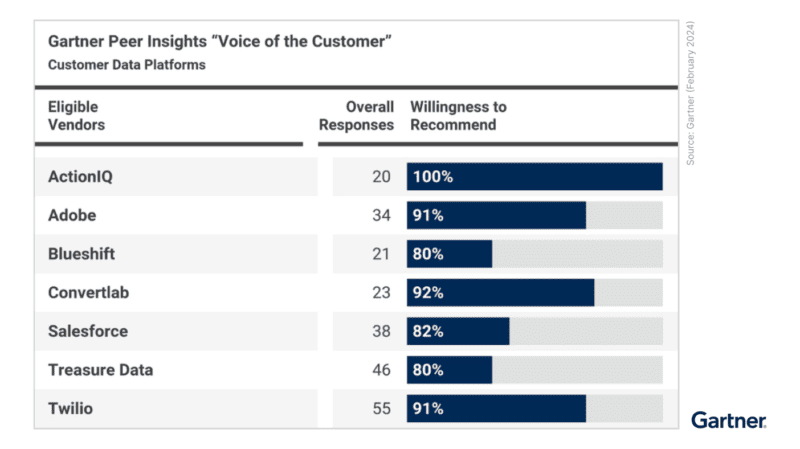Ask an Expert: Customer Data Platform Architecture

The Ask an Expert blog series is intended to help you answer the most critical questions related to marketing technology, customer data and customer experience with insights from industry experts. Check out our post on customer data platform architecture below.
“Customer data platform architecture” may sound highly technical, but it describes something very straightforward. Namely, the underlying systems that allow a customer data platform, or CDP, to do what it does.
But nailing down exactly what a CDP does — and the CDP capabilities required to do it — is easier said than done in the current marketing technology landscape.
Ever since digital became the de facto way of interacting with customers, businesses have been searching for a way to extract more value from their customer data. And with third-party cookie deprecation, brands are scrambling to get their first-party data strategy in order.
As a result, the CDP market is booming. Seemingly every martech vendor under the sun is introducing its own version of a CDP — and muddying the waters about customer data platform architecture in the process.
Read on to learn everything you need to know about CDP architecture with expert help from ActionIQ’s Head of Martech Strategy James Meyers.

What is Customer Data Platform Architecture?
Customer data platform architecture is the collection of systems that allow a CDP to accomplish its intended purpose: creating a customer 360.
“Different use cases have different workloads, and it takes a unique type of technology to fulfill those workloads,” Meyers said.
In the case of CDPs, that means technology to unify, cleanse, transform and store customer data to create comprehensive customer profiles. The resulting 360-degree customer view (aka customer 360) is the foundation of audience segmentation and journey orchestration.
A customer 360 is never truly complete — brands will want to enrich customer profiles over time as they add more data and channels. The goal is to centralize the relevant data you have in one location to create a single view of the customer, ensure that data is up to date and ready to be used, and then build on it over time while deduplicating customer profiles and resolving anonymous identifiers.
Customer data platforms make this possible, but only if they have the right architecture. And not all CDP architecture is created equal.
For instance, enterprise brands with millions of customers and numerous engagement channels will need a CDP that can quickly compute huge amounts of data and make it available for analysis and activation, as well as ingest data in different formats and connect to different tools throughout the wider technology stack.
This is why it’s essential for enterprise brands to invest in CDPs with enterprise-grade architecture.
How Do You Build a CDP?
It’s certainly possible for organizations to build their own customer data platforms, but there’s a reason many brands opt to buy one. Without the right people, processes and technologies in place, building a CDP from scratch is time-consuming and costly. And it will remain that way for as long as it needs to be maintained and updated for new data, integrations and use cases, which is to say, forever.
“You’re going to need talented software and data engineers,” Meyers said. “And from a technology side, you’re going to need to be able to cover the different types of workloads for what you want to do.”
At the very least, asking how to build a CDP means you’ll need to use an enterprise data warehouse (EDW) such as Snowflake, BigQuery or Amazon Redshift to manage analytical workloads.
“Workloads are queries or sets of instructions applied to your data,” Meyers said. “If the query or instructions contain lots of logic, that means the workload is heavy and requires infrastructure that can support it. For example, most segmentation queries are heavy workloads — that’s why they’re considered analytical. The logic is very extensive and complex.”
It’s important to remember that EDWs don’t come complete with APIs for data collection or the capabilities necessary to cleanse and transform data.
“In order to have a customer 360, you need to bring the data together, cleanse it, transform it and resolve the customer identity,” Meyers said. “Otherwise it’s not a customer 360 you can trust for your business use cases.”
If you’re planning to build a CDP in house, you’ll need to invest in those, as well as identity resolution capabilities to make sure customer profiles are known and accurate.
While event-based workloads — such as abandoned cart messages — only require simple if/then logic, you’ll still need to make significant investments if you’re looking to build real-time solutions on top of your CDP. This includes an event storage and stream-processing technology such as Apache Kafka for real-time triggering and a data management system similar to Apache Cassandra for analyzing data in real time. Finally, you’ll need people who know how to manage and integrate these technologies.
There are some organizations — especially among enterprise brands — that do indeed have the resources necessary to build their own CDP. But keep in mind that the real value of a customer 360 — beyond helping brands better know their customers — is in it being accessible to non-technical teams for marketing, sales and customer service activities.
If you’re building your own CDP, make sure it can be integrated with business-friendly solutions — and that these solutions have access to the full data inside the CDP instead of only a subset of it — to help non-technical teams segment audiences, orchestrate customer journeys and craft real-time experiences.
What Does a Customer Data Platform Do?
A customer data platform unifies both historical and real-time customer data, helping organizations create, resolve and enrich customer profiles to create a customer 360. By centralizing this data, brands can make it available to the teams that need it most while maintaining control of who has access to it and how it’s used across different systems.
But the real question is what a customer data platform makes possible. With a centralized source of customer truth to work off of and a comprehensive view of all customers, organizations can power applications on top of the CDP to more effectively segment and model audiences, helping them create more personalized and impactful experiences throughout multi-step customer journeys and real-time customer experiences.
The key is making sure the data within your CDP is accessible. If customer data is siloed behind technical gatekeepers, it has no value.
“CDPs power the applications that help organizations resolve the bottlenecks and technical challenges that prevent business teams from being focused on the customer,” Meyers said.
“When industry analysts describe the reasons organizations replace their CDPs, they talk about not having access to the full customer 360 or not being able to support effective segmentation.”
While some martech vendors may try to draw eyes with different bells and whistles, the value of a CDP comes down to its ability to handle analytical workloads — and its accessibility to your organization as a whole.
What Are the 4 Types of Customer Data?
While there are numerous customer insights brands can uncover using a CDP — including demographics, behaviors, preferences and more — customer data can be bucketed into four types based on how it’s collected: zero-, first-, second- and third-party data.
“Zero-party data is data you collect by explicitly asking your customers for it,” Meyers said. “It’s considered more accurate because you’re getting it straight from the customer instead of making an assumption based on their behavior.”
Say a brand sells audio equipment. If it asks customers whether they prefer one brand of speaker over another, that’s zero-party data. If it infers it based on which speaker customers are clicking on across its website, that’s first-party data.
Of course, constant questionnaires are unscalable and would make for poor customer experience. That’s why first-party data is the area brands are most focused on.
“First-party data can be broken down into anonymous and known,” Meyers said. “Then it’s up to brands to append that data — website clicks, past purchases, interactions across different touchpoints — to customer profiles to get a full view of their history with the brand.”
Next comes second-party data, which is first-party data that is not your own.
“Second-party data is first-party data another company has,” Meyers said. “You can use a clean room, if you have an agreement with the brand and they have an agreement with their customers, where they give you new customers that you don’t already have in your database.”
Imagine an airline and a hotel chain having a second-party data agreement. The airline could inform the hotel chain that a shared customer is traveling soon, and the hotel chain could then target that customer with ads for accommodations near their destination.
“In the absence of those agreements, what organizations do with second-party data is use it to match existing customers,” Meyers said. “If a customer exists in the two organizations’ separate databases, they can bring what they have together and fill in the gaps in their own customer profiles or build on what they know about a given customer.”
Then there’s third-party data, which is data you purchase from a data aggregator that gathers and resells it.
“Third-party data is generally used for enriching customer profiles,” Meyers said. “So if a company has a profile for a customer in their database and they want to know more about them, instead of entering into a second-party data relationship, they could buy data about the customer from another source.”
While this data can be helpful, it’s typically considered less trustworthy, and therefore less valuable, than data organizations collect themselves. First-party data, along with zero-party data, is considered the gold standard for building customer profiles.
With a CDP, brands can bring together all types of data — from zero-party to third-party — to create as clear a picture as possible of their customers.
Whether you’re buying or building a CDP, customer data platform architecture is important to consider carefully. But it’s just as important to understand what that architecture should be in service to: creating a comprehensive view of your customers — and making it available to the people who need it — in order to deliver extraordinary customer experiences.
Learn More About Customer Data Platform Architecture
Get in touch with our experts to discover how you can make the most out of your customer data platform architecture using the AIQ CX Hub.





